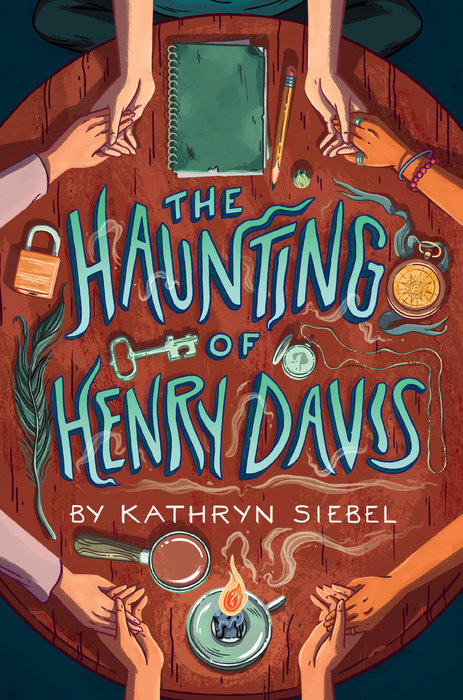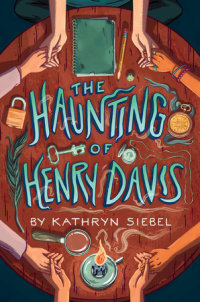The Haunting of Henry Davis
Two kids are about to find out that their lives are anything but ordinary when a ghost from the 1918 flu pandemic arrives and stirs up adventure. Perfect for fans of A Tale Dark and Grimm!
Ghosts only haunt when they've left something behind...
When Henry Davis moves into the neighborhood, Barbara Anne and her classmates at Washington Carver Elementary don't know what to make of him. He's pale, small, odd. For curious Barbara Anne, Henry's also a riddle--a boy who sits alone at recess sketching in a mysterious notebook, a boy, she soon learns, who's being haunted by a ghost named Edgar.
With the help of some new friends, this unlikely duo is off on an adventure to discover who Edgar was while alive and why he's haunting Henry now. Together, they might just help Edgar find what he needs to finally be at peace.
An Excerpt fromThe Haunting of Henry Davis
If you want my actual opinion, I’d have to say that it comes down to this: either you believe in them or you don’t. Ghosts, I mean. Sometimes that changes suddenly, of course. Usually, when one shows up in the middle of the night. But let’s just say you’re a skeptic, a doubter, like I was. I can respect that. Then, you have to start where I always do—with some research. And you have to be ready to uncover some things that you honestly can’t explain. So let me just tell you this one story. It’s about a woman in England who claimed her daughter was reincarnated and started to remember every bit of her past life.
It seems they were driving in the country one day, and the little girl made her mother stop the car in front of this random house. She screamed at her mother until she did it. And then she hopped right out and pushed through the gate and ran toward this cottage—in the middle of nowhere. Her mother followed her, of course.
“What is it?” she asked.
“I think I used to live here,” the girl said. “I’m sure I did.”
Creepy, right? And how would you have liked to be inside, sipping your tea or whatever, when the two of them showed up?
And then there are the kids with the “invisible friends.” Pretty common, really. Nobody else can see them except the kid. But they’re all alone in their room just chattering away. What explains that?
Or sometimes it’s an animal, like a dog. And it just stops in its tracks at a certain spot and starts barking like crazy. At nothing?
But maybe it’s something less obvious, like it was for me—with Henry. I don’t know how to explain it except to say that from the minute he walked into Ms. Biniam’s class on the first day of the fifth grade, there was something, well, familiar about Henry—which was impossible, really, because I’d never seen him before in my life. I guess you could call it déjà vu. You know, the feeling that you already recognize a place, or a person, from the first moment. It’s a real thing, and nobody understands exactly how it works— except some scientists say it’s your brain confusing the past and the present. Or maybe, like with that little girl in England, it’s one lifetime overlapping the next. I don’t pretend I can explain it all, even after everything that happened with Henry.
All I know is that Henry appeared that first day of school in the doorway of our classroom. And he was late. Biniam was already taking attendance and telling us where to sit.
“Henry Davis,” Biniam said, looking around.
“Here,” said Henry.
He took a step toward her, no doubt trying to ignore the fact that every kid in the room was staring at him. Even aside from being late, Henry didn’t make a great first impression. It almost looked like he was trying hard not to. First off, there was the way he dressed. He could have made Guinness World Records for Biggest Nerd looking like that. His pants were much too short, his glasses were strapped onto his head with one of those elastic straps that should never leave the basketball court, and his T-shirt said Karsoff Chess Academy—Your Move!
The rest of us were waiting in our pods—the little squares of desks that Ms. Biniam had assigned us. Across from me was Zack Martin, the biggest kid in class. He had a buzz cut, braces, and a fairly bad attitude. Kitty-corner was Renee Garcia, who had the longest hair and the darkest brown eyes I’d ever seen. Then, next to me, was an empty desk that I knew, somehow, belonged to Henry Davis.
When Biniam sent Henry our way, Zack made a little grunting sound and said, “Figures.” Then he slumped even farther down in his seat and stuck one big foot out toward Henry, so that Henry tripped and crash-landed into the seat next to me. That’s how fifth grade started for Henry. Biniam gave Zack the first of about a thousand glares she would aim his way before the year was up.
And Henry, well, poor Henry. He looked pale and exhausted. How else was he supposed to look? I didn’t know it yet, of course, but that morning Henry Davis had seen his very first ghost.
I couldn’t do anything about Ms. Biniam’s seating chart, but outside class, I didn’t spend much time with Henry at the beginning. My mother, like every mother since the dawn of time, always reminded me to be nice to the new kid. And it wasn’t that I was mean to Henry. I said hello to him when he sat down next to me each morning. I was friendly. But I didn’t exactly go out of my way to spend time with him. And that’s just how it is, mostly, with new kids. Especially at lunch.
Well, apparently, teachers had noticed this too, which was why we all got stuck with this new program, twice a week, called Stir-It-Up Lunch, which is as horrible as it sounds. Everybody draws a colored slip of paper, and that determines which lunch table you sit at twice a week FOR THE WHOLE YEAR. They don’t even sort you by grade. Henry and I landed at the Blue Table, with a bunch of little kids. The worst was this first-grade boy named Rodney, who still wiped his nose on his sleeve.
“Rodney,” I kept saying. “Do you want a Kleenex?”
“No.”
Henry looked at me and shook his head sadly. “So gross,” he said. Rodney could hear him too, but he didn’t even seem to mind.
“I’m losing my appetite,” I said to Henry.
Henry didn’t answer. He was busy arranging each part of his lunch on top of his lunch bag. Cheese sandwich, carrot sticks, granola bar. I didn’t know it yet, but that was Henry’s standard lunch. And by “standard,” I mean that he ate it every day for the whole school year as far as I could tell. Not only that, but he ate it in the same order every time and finished all of each item before he moved on to the next. He’s one of those kids who won’t let any of the food touch on his dinner plate.
Somewhere between the last carrot stick and the granola bar, Rodney sniffed so loudly that it was really more of a snort. The littler kids at the table thought it was hilarious, but Henry and I had had enough.
“We need to get out of here,” he told me.
And that’s how it started. Henry and I would take a few bites, then hide the rest of our lunch in a jacket pocket and escape to the playground. Nobody else was outside yet, so we just started sitting together, sharing cookies under the slide. We didn’t even talk much, which is unusual for me. We just sat there chewing and staring at the wood chips. Once I had finished, I’d dust myself off and get up to go find someone I knew.
“Bye, Henry,” I’d say.
And he would nod and take out his sketchbook. That’s how it went for a few weeks. Henry and I left every Stir-It-Up Lunch early, and the rest of the Blue Table just watched us go.
Eventually, of course, somebody caught on. The somebody in this case


